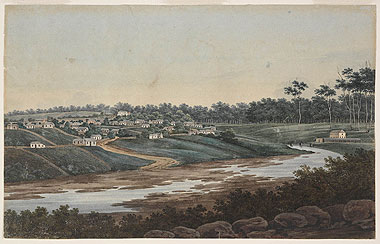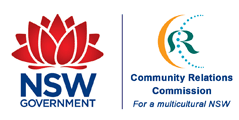The Age of Macquarie: Exploration of NSW interior & coastline, 13 counties established to control land usage in areas beyond government control. Wool industry developed, farming developed and free settlement begins

A view of part of Parramatta Port Jackson, J.W. Lewin, 1809, PXD 388, Mitchell Library, State Library of New South Wales.
Between 1789 and 1791, the Colony at Sydney Cove was critically short of food. To make matters worse, the supply ship Guardian was wrecked off South Africa before it reached the Colony, and HMS Sirius, one of two of the Colony’s Navy vessels, was wrecked on Norfolk Island en route to China seeking food. In desperation, the HMS Supply, the Colony’s second Navy ship, was sent to Indonesia for food. Hopes were raised when a vessel arrived in Port Jackson in 1790, but it was not the Supply, but the Second Fleet of five ships carrying over 730 people. This Second Fleet was a disaster, with its human cargo severely abused and exploited by the private ship owners. Of 1000 convicts on board, 267 died and 480 were sick from scurvy, dysentery and fever. The supplies on board the Second Fleet were supposed to feed the convicts, but the ship owners withheld the supplies for sale until after the convicts disembarked. Phillip, enraged by this behaviour as he had to further ration existing supplies, became desperate to establish farms and a local economy.
Farms, established at Rose Hill (Parramatta) and later at Richmond and Windsor, were soon producing crops. Explorers set out to find new land and areas were opened up in the Liverpool area for market gardens, viticulture and sheep grazing for wool.
As the Colony expanded, new land was needed for farms and the new cash crop of wool, with sheep runs getting bigger and bigger. Several ex NSW Corps and ex-convict businessmen were becoming wealthy by exporting wool to England. They also had become quite powerful and even deposed a Governor named Bligh who tried to control their business activities.
Governor Lachlan Macquarie took control of NSW in 1810 and immediately got to work and dismissed all officials who had been appointed by the NSW Corps, and restored the people who had been in those jobs before the Rum Rebellion. One of his first actions was to reduce the number of licensed public houses in Sydney from 75 to 20, though very soon after their number was much increased, and he began the widespread building program that characterised his administration. The streets were straightened and improved, new barracks were built for his regiment, and the NSW Corps was sent back to England. In November he began a tour of the colony and in little more than a month was able to form some opinion of its capabilities.
To the west of Sydney, the Blue Mountains presented a physical barrier and Macquarie set the challenge to find a passage. In 1813, explorers Blaxland, Lawson and Wentworth crossed the Blue Mountains and found rich grass plains as far as the eye could see. This was an economic bonanza for the New South Wales businessmen. The Government tried to regulate land use by setting up 13 counties radiating out from Sydney for 200 miles in all directions. Land use beyond these was forbidden. This was hard to enforce and businessmen sent shepherds into the frontier to ‘squat’ and graze sheep. Eventually the businessmen claimed this land as their own and became known as ‘squatters’. All the while Aboriginal people were being forced off their homeland and in many cases murdered if they resisted.
Around this time Matthew Flinders was exploring the coastline of New South Wales and New Holland. In 1802-03, Finders circumnavigated the continent and was the first person to use the term Australia when referring to the whole continent of New Holland, New South Wales and Van Diemens Land.

